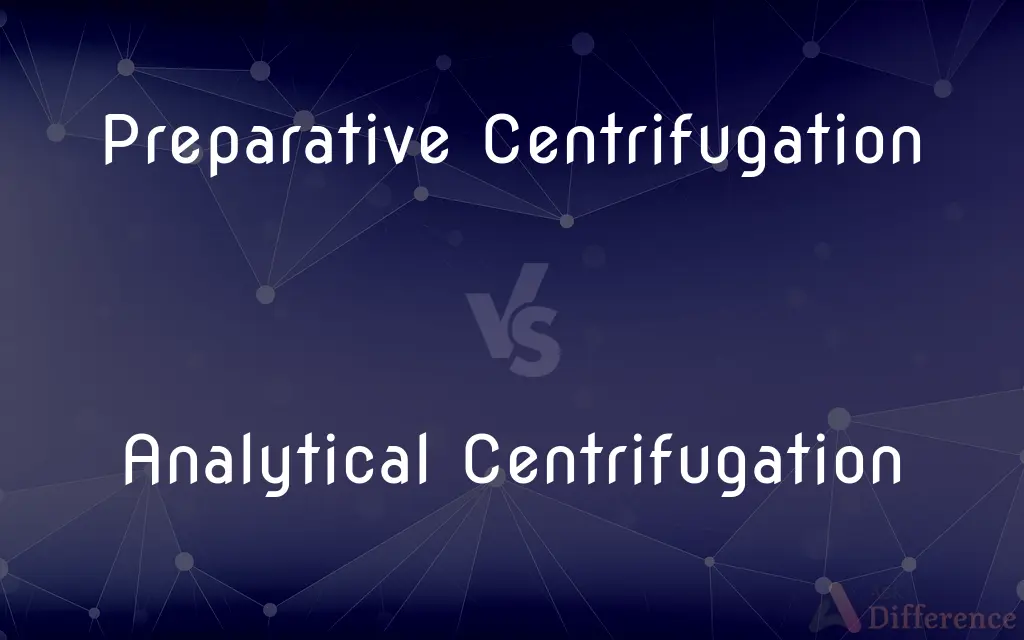Preparative Centrifugation vs. Analytical Centrifugation — What's the Difference?
Edited by Tayyaba Rehman — By Fiza Rafique — Published on December 4, 2023
Preparative Centrifugation isolates and purifies components, while Analytical Centrifugation characterizes those components' properties without isolating them.

Difference Between Preparative Centrifugation and Analytical Centrifugation
Table of Contents
ADVERTISEMENT
Key Differences
Preparative Centrifugation is designed to separate and collect cellular components or molecules for subsequent use or study. On the other hand, Analytical Centrifugation is a method that provides information about the properties of particles without necessarily isolating them.
The primary goal of Preparative Centrifugation is purification. Scientists deploy it when they aim to obtain relatively large quantities of specific components, like proteins, from a mixture. In contrast, Analytical Centrifugation examines a sample's physical properties, such as size, shape, density, and distribution, aiding in the understanding of molecular behavior.
When conducting Preparative Centrifugation, the focus is on collecting the separated components post-centrifugation. This approach is highly useful in biochemistry and molecular biology. Meanwhile, Analytical Centrifugation offers real-time data collection during the centrifugation process, allowing researchers to monitor the sample's behavior dynamically.
In a lab setting, Preparative Centrifugation often precedes other experimental procedures, as it provides purified materials required for further studies. Analytical Centrifugation, conversely, is more of an endpoint procedure, providing insights into the interactions, sedimentation rates, and molecular weights of particles in the sample.
It's crucial to discern that while both Preparative and Analytical Centrifugation utilize centrifugal forces, their applications, intentions, and outcomes are distinct, catering to different scientific needs.
ADVERTISEMENT
Comparison Chart
Main Purpose
Isolation and purification
Characterization
Outcome
Separated components collected
Data on particle properties
Role in Research
Provides material for further study
Provides insights into molecular behavior
Data Collection
Post-centrifugation
Real-time during centrifugation
Typical Use
Biochemistry, molecular biology
Physical chemistry, biophysics
Compare with Definitions
Preparative Centrifugation
A centrifugation technique aimed at separating and collecting components.
The researcher used Preparative Centrifugation to isolate specific proteins from the cell lysate.
Analytical Centrifugation
A study of samples to ascertain physical properties via centrifugal forces.
With Analytical Centrifugation, the sedimentation rates were easily determined.
Preparative Centrifugation
Centrifugation with the intent of preparing samples for subsequent research.
Before analyzing protein interactions, Preparative Centrifugation was necessary to obtain purified samples.
Analytical Centrifugation
A technique that characterizes particle properties using centrifugation.
Through Analytical Centrifugation, scientists determined the molecular weight of the novel protein.
Preparative Centrifugation
A preparatory technique ensuring sample purity via centrifugation.
The team relied heavily on Preparative Centrifugation to ensure the integrity of their samples.
Analytical Centrifugation
A method providing real-time data during the centrifugation process.
The team was intrigued by the dynamic results obtained through Analytical Centrifugation.
Preparative Centrifugation
The use of centrifugal forces to isolate desired components in substantial amounts.
The breakthrough in the study was possible due to the efficiency of Preparative Centrifugation.
Analytical Centrifugation
Centrifugation offering insights without necessarily isolating components.
The density and distribution of particles were studied using Analytical Centrifugation.
Preparative Centrifugation
A method focused on purification using centrifugal force.
Preparative Centrifugation allowed the lab to gather sufficient DNA for the experiment.
Analytical Centrifugation
A centrifugation approach focused on understanding molecular behavior.
Analytical Centrifugation shed light on the unique interactions between the two molecules.
Common Curiosities
What is preparative centrifugation?
It is a centrifugation technique used primarily to isolate, purify, or concentrate specific particles, cells, or molecules from a heterogeneous mixture.
What are the common applications of preparative centrifugation?
It's used in biochemistry, cell biology, and molecular biology to separate cells, organelles, membranes, and large molecules.
Which types of centrifuges are typically used for preparative purposes?
Common types include benchtop, high-speed, and ultracentrifuges.
Is analytical centrifugation suitable for heterogeneous samples?
Yes, it can provide insights into the properties and behavior of individual components within heterogeneous mixtures.
Which centrifugation method is more time-consuming?
Preparative centrifugation often requires more time, especially if large particles or volumes are involved.
Can both techniques be applied to the same sample sequentially?
Yes, a sample can first be analyzed using analytical centrifugation and then further processed using preparative centrifugation.
Can preparative centrifugation be used for large sample volumes?
Yes, depending on the type of centrifuge and the rotor capacity, it can handle large sample volumes.
How does it provide analytical data?
By observing the sedimentation rate or the diffusion behavior of particles, one can infer properties like size, shape, and interactions.
Can analytical centrifugation be used for protein characterization?
Yes, it's commonly used to study protein-protein interactions, protein conformations, and molecular weights.
How is it different from analytical centrifugation?
Preparative centrifugation aims to physically separate components for further use, while analytical centrifugation is used to study the properties and behaviors of particles.
What is analytical centrifugation?
It's a technique used to study the properties, behaviors, sizes, and molecular weights of particles in a solution without necessarily isolating them.
What are the main types of analytical centrifugation?
Sedimentation velocity and sedimentation equilibrium are the primary types.
Are there any safety concerns with these centrifugation methods?
Yes, improper balancing, use of damaged rotors, or exceeding recommended speeds can result in equipment damage or injury.
How are samples typically prepared for these centrifugation methods?
Samples should be free of bubbles, properly balanced across tubes, and introduced into the appropriate tubes or containers for the centrifuge model.
Which method is better for studying virus particles?
Both methods have their merits. Preparative centrifugation can concentrate virus particles, while analytical centrifugation can provide insights into their size, density, and interactions.
Share Your Discovery

Previous Comparison
Pure Research vs. Applied Research
Next Comparison
Afferent Neurons vs. Efferent NeuronsAuthor Spotlight
Written by
Fiza RafiqueFiza Rafique is a skilled content writer at AskDifference.com, where she meticulously refines and enhances written pieces. Drawing from her vast editorial expertise, Fiza ensures clarity, accuracy, and precision in every article. Passionate about language, she continually seeks to elevate the quality of content for readers worldwide.
Edited by
Tayyaba RehmanTayyaba Rehman is a distinguished writer, currently serving as a primary contributor to askdifference.com. As a researcher in semantics and etymology, Tayyaba's passion for the complexity of languages and their distinctions has found a perfect home on the platform. Tayyaba delves into the intricacies of language, distinguishing between commonly confused words and phrases, thereby providing clarity for readers worldwide.












































